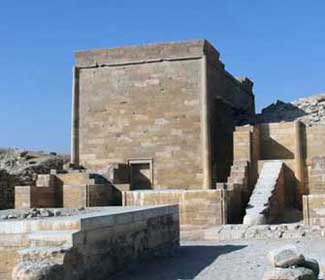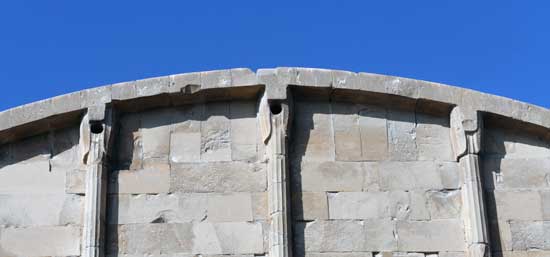On the west side were at least thirteen chapels, of two basic types. The first, of which there were three examples, had a flat roof with torus mouldings at the corners and a curved overhang

at the top, what came to be known as a cavetto cornice. It is a stone version of an orginal prototype made out of reeds, supported by rolled bundles of reeds and with an overhanging fringe. There was a false door set in a recess in the middle of the façade and a deeper niche just around the corner, on the north side where offerings could be presented. This type of shrine is known as a sah netjer (“Hall of the God”) and was connected with the cult of the god of the dead, the jackal god Anubis. There is one at either end of the row and another in the middle.
The other ten shrines on the west side were of the per wer (“Great House”) type, a form characteristic of Upper Egypt in the Predynastic Period and symbolic of that part of the country thereafter. The prototype was a light, wood- framed structure with a low vaulted roof supported by three engaged, fluted columns. It has long been held that these were copies of wooden posts that had been shaped by an adze. However, it has been suggested that they may represent the stem of the Heracleum giganteum, a type of

Capitals of the columns on the facade of one of the per uer shrines
hogwood. The capitals are very distinctive. Each was formed of a pair of pendent leaves (or dead heads of the hogwood flower?) that framed an abacus, the block at the top that supported the

ridgepoles. The latter evidentlyprojected well out from the façade, given the standard depiction of the type in Egyptian art (far right). Lauer believes that, in this case, the sockets held heraldic images of the god or goddess worshipped within.
In the middle of the façade was a doorway that led to a small room with a ceiling made up of stone rafters carved to replicate palm logs. At the rear of the sanctuary, at about head height, was a small niche with a ceiling that copied the double-curved roof of the prototypical shrine.
A least two of the chapels—the southernmost pair—had a steep set of sloping steps leading to a large niche where a statue presumably had once stood, waiting to receive offerings. Three caryatid statues of a mummiform Djoser were found lying on the ground on the other side of the courtyard but there is no indication of their intended location. One was broken and the other two were unfinished.







0 التعليقات:
إرسال تعليق